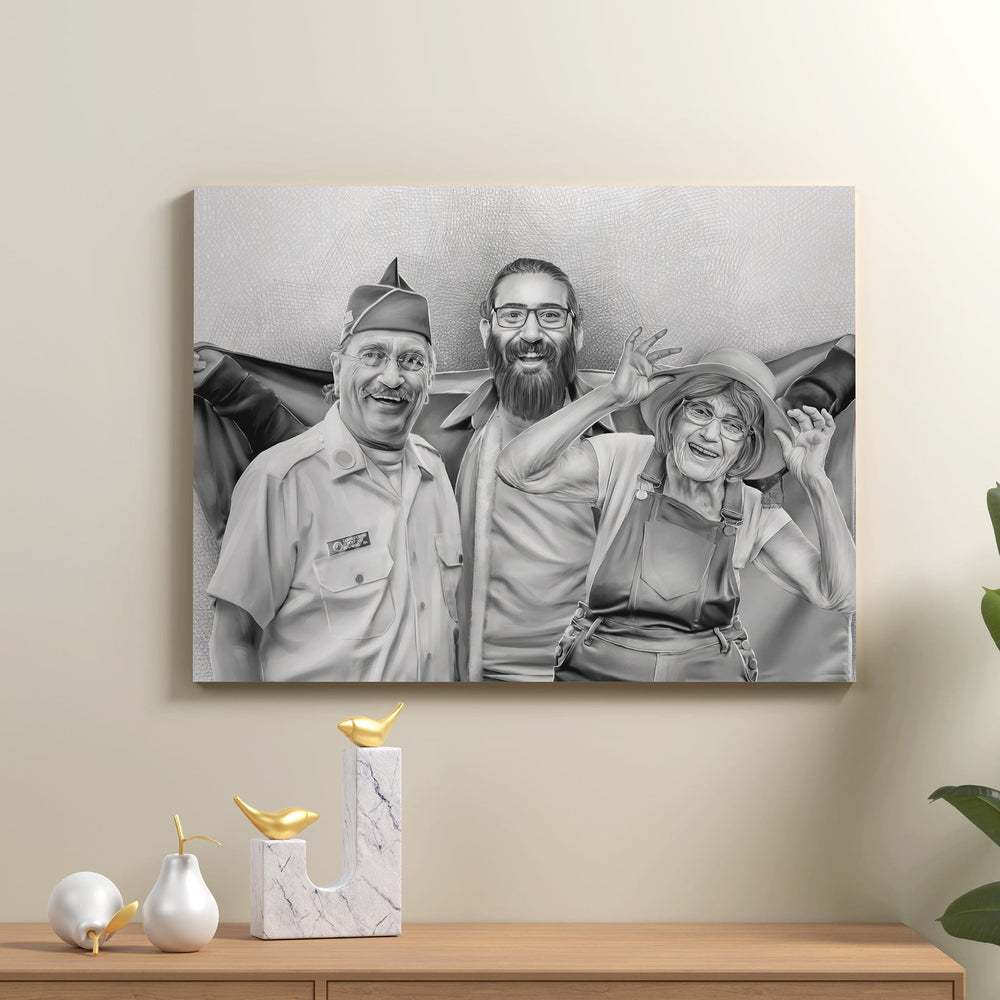Oil Painting Process: How to Determine Your Art's Value


Photo by Catherine Kay Greenup on Unsplash
Are you an artist looking to understand how to determine the oil painting prices? Valuing art can be a tricky process, and it's important to understand the factors to help you decide on painting canvas prices.
Determining the value of your art is a key part of being a successful artist. Knowing how to value your piece of art properly can help you get the most out of your work financially and help you set a fair price for future sales.
From the 15th century to the modern era, artists like Jan Van Eyck, a renowned Flemish painter, Jackson Pollock and other contemporary artists have shaped the art world. Understanding the difference between oil painting techniques from different eras and styles, like the egg-based tempera paintings of the past and the complex painting methods of today, is crucial
Importance of Properly Pricing Oil Paintings
It is important for professional artists to know how to properly price their artwork in order to maximize their profits and ensure that their original painting is valued for its quality. This includes understanding the market of oil painting, from canvas oil painting prices to those of oil painting reproductions.
The inventory of oil paintings and collection of paintings you have, whether they are landscape oil painting, linen landscape painting, or custom Art Portrait Landscape, plays a role in determining value. For instance, a Horse portrait or realistic portraits often have different valuations compared to contemporary paintings.
Setting a good price for your painting is an important part of being a successful artist. Consider the cost of materials, the size and complexity of your painting, the current market, and the emotional value of your painting when determining the value of your work. Doing so will help ensure that you get the most out of your art.
Factors to Consider For Oil Painting Price Range

Get Your Own Memorable Oil Painting Here
Creating painting prices can be a challenging task for any artist. It requires a careful balancing act between producing an artwork of value and pricing it at a level that will attract customers. The following are some factors to consider to know how to price an oil painting.
Cost of Materials
When deciding on a price range for an oil painting, one of the most important factors to consider is the cost of materials. This includes the type of frame used, be it a wooden frame or a Canvas Linen Panel Oil Pastel Frame, and frame pricing considerations.
Customization in oil painting can also affect costs. Choosing between a cheaper painting option and more expensive material like a hard-shell tube or a tin tube for shipping can impact the final price.
Oil Painting Style
Understanding the common oil painting techniques used by various masters of painting through the 20th centuries is vital. The methods of painting and the finishing for oil painting can greatly vary, affecting the overall aesthetics and value of the work.
Oil painting styles are typically divided into two categories: traditional and modern. Traditional oil painting styles are often associated with realism and representational art and may include classical still life, landscape, and figure painting. It typically involves the use of thick paint layers, often applied with a brush.
On the other hand, modern styles are often associated with abstraction and are often characterized by the use of thin layers of paint and the use of various tools and techniques such as palette knives and sponges.
Another factor to consider when determining the painting prices is its complexity. If it is more complex and has more detail, then it will cost more than a painting with less detail.
Layers of Paint
Depending on the painting, the number of layers used can vary greatly and have a direct impact on the overall painting prices.
The first layer of paint is called the “primer.” This is a very thin layer that is applied to the canvas to prepare it for painting. The primer helps to seal the canvas and provides a smoother surface for the paint to adhere to. This layer is typically the cheapest and priced in square inches.
The next layer is the “base” layer. This is the main coat of paint that will provide the foundation of the painting. This layer is usually applied with a brush or roller, and it gives the painting its overall color and texture. Depending on the complexity of the painting, this layer can be fairly expensive.
The third layer is the “undercoat.” This layer of paint is used to give the painting added depth and texture. This layer is usually applied with a brush or roller and can have an additional cost.
Size of Artwork
The cost of an oil painting on canvas is usually determined by its size. Generally, the larger the painting, the more expensive it will be. This is because larger pieces require more materials, such as paint and canvas, and more time to complete. This means that the artist must charge more for their time and materials.
Additionally, the complexity of the painting also factors into the price. A larger painting can take longer to complete and may require more intricate details and brush strokes. A small oil painting will have less effort. Hence, its price is lower.
Quality of Original Oil Paintings
When assessing the quality of an original oil painting, there are several factors to consider. First, the skill level of the artist can play a role in the quality of the piece. Well-known artists who have honed their craft over years of practice and experience will naturally produce higher quality works than novice painters.
The materials used in the painting's production should also be taken into account. Higher-quality paints and canvases will generally produce a more vibrant and durable painting. The painting's condition also has an impact on its quality. Minor imperfections such as scratches or small tears can detract from the painting's overall appeal.
Methods to Determine How Much Are Paintings Worth

Many paintings can range in value depending on multiple factors such as the artist, subject matter, medium, and condition. Here are some methods to help you determine how much a painting is worth.
Examine The Oil Paint
A painting with high-quality brush strokes and vivid colors is likely to be more valuable than a painting with sloppy brush strokes and dull colors. Also, look for signs of aging, such as yellowing of the paint, cracked paint, and discoloration. The age and condition of the painting will also affect its value.
Is the painting realistic or abstract? Does it feature a single subject or multiple subjects? Is the painting symmetrical or asymmetrical? Is the painting a landscape, still life, portrait, or something else? All of these factors will influence the value of the painting.
Know The Artist
Researching the artist’s biography will provide insights into their artistic style, as well as their place in the art world. Knowing the artist’s place in the art world gives an indication of the worth of the work, as well as its potential as an investment.
The artist’s name can also add to the painting’s value. For example, the work of a famous artist such as Picasso or Francis Bacon will be worth much more than a painting by an unknown artist, as it has a greater reputation and desirability.
Use Painting Pricing Guide
A painting pricing guide is essentially a list of the market values of different types of paintings. It is based on factors such as the artist's reputation, the painting's condition, size, and the medium used. The guide also takes into account the demand for the particular painting and the current market prices of similar works.
The most common type of pricing guide is a reference book, which provides a list of current selling prices for artwork. This type of guide is a great resource for art buyers, as it can help them determine if a painting is a good investment and if it is worth the asking price.
For sellers and collectors, a pricing guide can provide an estimate of the value of a painting. This can also be used to help identify works of art that may be undervalued or overvalued in the market.
Common Mistakes to Avoid When Pricing Oil Paintings

Order your custom wedding oil portrait here
Whether you are a professional painter or just starting out, it’s important to price your artwork accurately and realistically. Here are some common mistakes to avoid when pricing oil paintings.
Not Considering The Details of Portrait Paintings
When it comes to pricing oil paintings, one of the most common mistakes people make is not considering the details of the portrait paintings. While it may seem obvious, the details of each painting can have a profound impact on the value and price of the piece.
From the artist’s signature and the type of canvas used to the quality of the brushwork and the age of the painting, all of these details are important when it comes to accurately price a piece.
Not Accounting The Artist's Experience
An experienced artist will likely have more knowledge about the techniques and materials used to create a painting and thus will be able to produce a higher-quality piece. Similarly, if the artist has a good reputation and a solid portfolio of past work, this can add to the painting's value.
If the painting is complex and requires a lot of skill to complete, the artist should be compensated accordingly. Similarly, if the painting requires a lot of time, the artist should be given credit for their effort.
Final Thoughts
Determining the value of your oil painting is important in order to ensure that you are able to properly insure it, protect it from depreciation, and maintain its worth over time. Additionally, understanding the value of your painting can help you appreciate its true worth and can provide you with a sense of satisfaction and pride that comes from knowing the value of something that you have invested your time, effort, and money into.
Own an Oil Painting Portrait from Memorialize Art

Get Your Own Family Oil Painting Here
With our custom artwork, you can transform a photo into a stunning oil painting that will last as a cherished keepsake for years to come. Whether you’re looking to decorate your home, give a unique gift, or just create a lasting memory, Memorialize Art has the perfect solution. With our easy ordering process and fast shipping, you’ll have your custom oil painting in no time.










